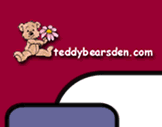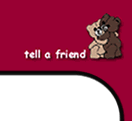|
|
TIPS FOR LAYOUT & CUTOUT
Tips & Hints | Bear Making Terms
|
HINT
Bear Making is supposed to be fun! Consider creating several bears, working at each one in stages... if you have more than one bear on the go you can have a bear to suit your mood and creative urge.
|
|
The layout below shows how to get a 16" bear out of a fat quarter.

|
BIG HINT
You can always "shorten" the limbs and body a smidgen to avoid purchasing a bigger pied of that precious mohair
|
-
Make a template - to have pattern pieces that can be used over and over again. Cereal boxes, file folders, used X-ray film can be used to make a template. Either glue your pattern to the cardboard or trace onto film. Transfer all the markings and punch out joint holes. Straight of grain arrows are important. You may choose to make a template for every piece you are going to cut (i.e. both side heads, two inner and outer legs, etc. etc.)
-
Establish the direction of the pile of the fabric by stroking it. The fur lays smoothly "with" the nap and stands up when brushed against the nap. Mark the nap direction with arrows on the backing.
-
Lay fabric fur side down on a clean work surface with the nap running down.
-
Arrange templates (cardboard pattern pieces) on the fur backing. Check that the pieces are aligned with the nap according to the directional arrows.
| (a) |
"Grain" is just as important as the nap. A piece which has been cut off grain can twist when sewn and stuffed. Lay out the pattern pieces so that the grain line arrow is parallel to the grain of the fabric. |
| (b) |
Place the pattern templates as close together as possible to conserve mohair. We've learned that many a "Beans" or "Little Beans" can be made from the leftover. |
| (c) |
To create a bear with a different look, consider placing pattern pieces against the grain. |
-
Using a soft lead pencil, crayon, china marker pen, or permanent laundry pen, transfer your pattern pieces to your fabric. Be really cautious about ball point ink and felt tip marker. The colour may travel or bleed, especially with light colour fabrics.
| (a) |
Hold pen vertical as you trace to get a best proportional bear. |
| (b) |
If you have not made a template for each piece then reverse pattern pieces as needed. When a pattern says "Cut 1, Cut 1 Reverse" trace around the piece once and then turn it over and trace it again. |
| (c) |
Mark joint and eye placement. |
Before you cut, do a final check. Are there enough pieces? Did you "reverse" all pieces except the gusset?
2 bodies
4 ears
2 or 4 arms
2 or 4 legs
2 side head
1 gusset
-
Treat yourself to a pair of small bladed, sharp scissors. The "gold standard" are Gingher which cut mohair like a knife through soft butter.
-
Cut only the backing by taking small snips just inside the traced line. The small snips guard against "offcuts" or gouges out of the fur fibers.
-
Once your pieces are cut, then gather them carefully and give them a good shake outside to loosen the fur fibers. Nice if there's a wind blowing!
-
Place the pieces carefully away until you are ready to pin.
|
HINT
Some bear makers save the scrap and use as part of the belly stuffing. If you need to do repairs or replace an ear - voila!, matching fabric right at your fingertips. Think about small pieces that could be incorporated into the figured bear of many fur finishes.
|
MORE HINTS:
- For bears under 8 inches, cut ears in a circle (subtract seam allowance from the pattern along the bottom edge). Using this circle technique helps reduce the excess fabric on the corners. To finish, sew curved edge, slit along center of the folded edge and turn.
- If fabric is loosely woven, then add 1/4" to "openings". This extra allowance will help get a clean edge when closing.
- Fray check helps create a stiffer edge and reinforcement. Use very sparingly at "opening" edges, side head and gusset muzzle area and along bottom of legs where foot pads will be inserted. You can also use watered down white glue.
- If the fur is synthetic with a stretchy backing, then use iron on interfacing to strengthen the backing and stop your bear from bulging out.
- If you have purchased a piece of mohair - keep if looking beautiful by hanging it by the selvage edge.
|
 Adopt a Panda or Polar Bear Today!
Adopt a Panda or Polar Bear Today!
Post a Message on our Message Board!
Home | The Den Shop | Artist Den | Teddy Tutor | What's New | Interact | The Den Links
Forget-Me-Not | Web Design | Guestbook |
All rights reserved Phone: Hilde (604) 929-3150 or (604) 873-3300
Hours: 9 am to 6 pm PACIFIC TIME
Fax: (604) 608-3577
Email:
Back to Top

This page is dedicated to all those lost but not forgotten Teddy BearsMohair
|






